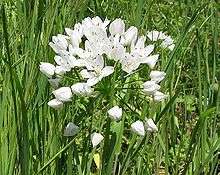Allium neapolitanum
| Neapolitan Garlic | |
|---|---|
 | |
| Allium neapolitanum | |
| Scientific classification | |
| Kingdom: | Plantae |
| Clade: | Angiosperms |
| Clade: | Monocots |
| Order: | Asparagales |
| Family: | Amaryllidaceae |
| Subfamily: | Allioideae |
| Genus: | Allium |
| Species: | A. neapolitanum |
| Binomial name | |
| Allium neapolitanum Cirillo | |
| Synonyms[1] | |
| |
Allium neapolitanum (Neapolitan Garlic,[2] Naples Garlic, Daffodil Garlic, False Garlic, Flowering Onion, Naples Onion, Guernsey Star-of-Bethlehem, Star, White Garlic, Wood Garlic) is a perennial bulbous plant in the onion subfamily within the Amaryllis family.
Its native range extends across the Mediterranean Region from Portugal to Turkey.[3][4]The species is naturalized in other areas, including Pakistan, Australia, New Zealand, and in southern and western parts of the United States. It is classed as an invasive species in parts of the U.S.,[5] and is found primarily in the U.S. states of California, Texas, Louisiana, and Florida.[6][7]
Allium neapolitanum is cultivated by gardeners for its ornamental value. It produces round bulbs up to 2 cm across. Scape is up to 25 cm tall, round in cross-section but sometimes has wings toward the bottom. Inflorescence is an umbel of up to 25 white flowers with yellow anthers.[6][7][8][9]
Allium neapolitanum seems to have beta-adrenergic antagonist properties.[10]
References
- ↑ The Plant List
- ↑ "BSBI List 2007". Botanical Society of Britain and Ireland. Archived from the original (xls) on 2015-02-25. Retrieved 2014-10-17.
- ↑ Kew Botanical Gardens, World Checklist of Selected Plant Families, Allium neapolitanum Cirillo
- ↑ Altervista Flora Italiana, Allium neapolitanum
- ↑ United States Department of Agriculture Plants Profile
- 1 2 Allium flower, Allium neapolitanum
- 1 2 Flora of North America v 26 p 257 Allium neapolitanum
- ↑ Cirillo, Domenico Maria Leone. 1788. Plantarum Rariorum Regni Neapolitani 1: 13.
- ↑ Hickman, J. C. 1993. The Jepson Manual: Higher Plants of California 1–1400. University of California Press, Berkeley.
- ↑ Nencini C, Franchi GG, Micheli L (June 2010). "Cardiovascular receptor binding affinity of aqueous extracts from Allium species". International journal of food sciences and nutrition 61 (4): 433–9. doi:10.3109/09637481003591608. PMID 20446820.
.jpg)